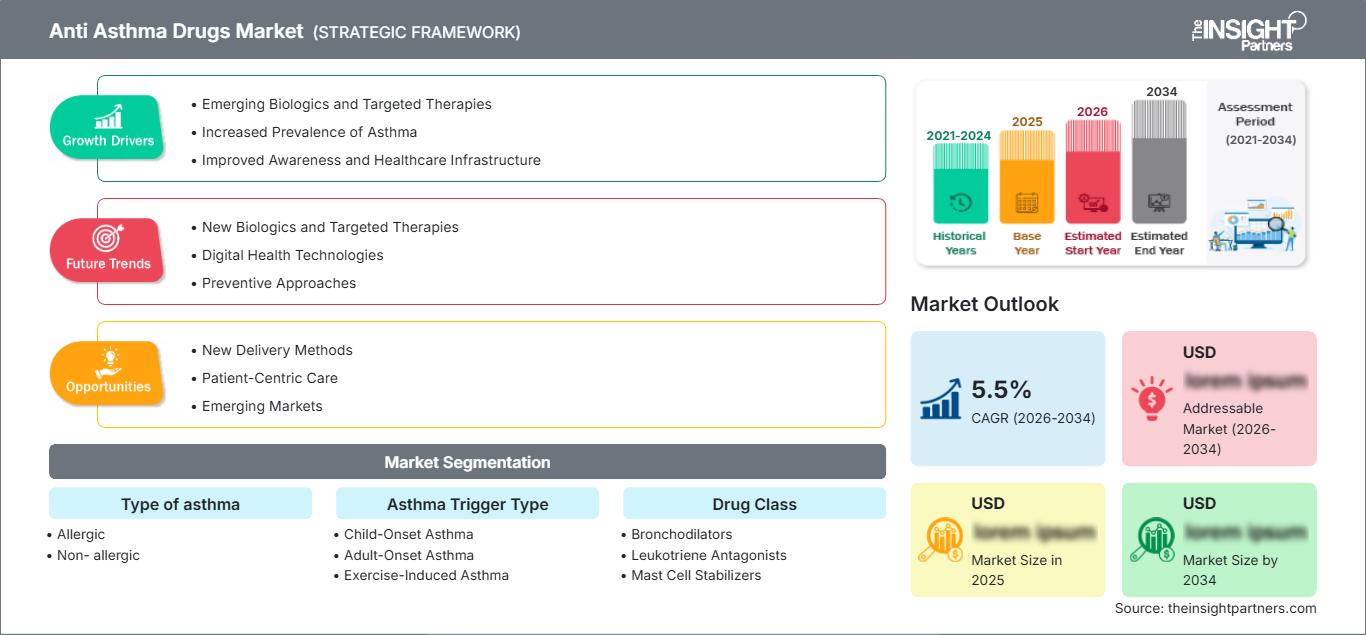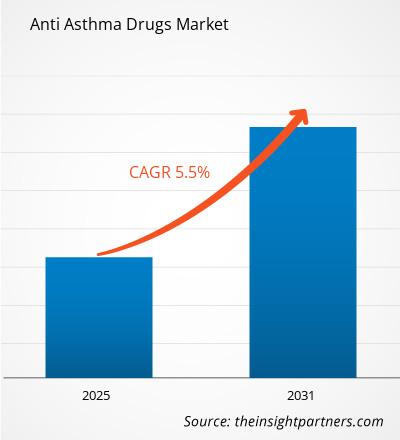预计2026年至2034年,抗哮喘药物市场将以5.5%的复合年增长率增长。市场环境持续变化,为利益相关者带来新的机遇。整体而言,市场呈现稳定发展态势,并具有长期增长潜力。
抗哮喘药物市场报告按哮喘类型分为过敏性哮喘和非过敏性哮喘。哮喘诱发因素包括儿童期起病哮喘、成人期起病哮喘、运动诱发性哮喘、咳嗽诱发性哮喘、职业性哮喘、夜间哮喘和激素抵抗性哮喘。药物类别包括支气管扩张剂、白三烯拮抗剂、肥大细胞稳定剂、皮质类固醇和单克隆抗体。给药途径包括口服、吸入、静脉注射和皮下注射。
上述细分市场分析的市场评估以美元计价。全球分析按区域和主要国家/地区进行细分。上述细分市场分析的市场评估以美元计价。报告目的
Insight Partners 发布的《抗哮喘药物市场报告》旨在描述当前市场格局和未来增长、主要驱动因素、挑战和机遇。这将为各类商业利益相关者提供洞察,例如:
- 技术提供商/制造商:了解不断变化的市场动态和潜在增长机会,从而做出明智的战略决策。
- 投资者:对市场增长率、市场财务预测以及整个价值链中存在的机遇进行全面的趋势分析。
- 监管机构:规范市场政策和监管市场活动,以最大限度地减少滥用行为,维护投资者信任和信心,并维护市场的完整性和稳定性。
抗哮喘药物市场细分 哮喘类型
- 过敏性哮喘
- 非过敏性哮喘
哮喘诱发因素类型
- 儿童期起病哮喘
- 成人期起病哮喘
- 运动诱发性哮喘
- 咳嗽诱发性哮喘
- 职业性哮喘
- 夜间哮喘
- 激素抵抗性哮喘
药物类别
- 支气管扩张剂
- 白三烯拮抗剂
- 肥大细胞稳定剂
- 皮质类固醇
- 单克隆抗体
给药途径
- 口服
- 吸入
- 静脉注射
- 皮下注射
您将免费获得任何报告的定制,包括本报告的部分内容,或国家级分析、Excel 数据包,以及为初创企业和大学提供超值优惠和折扣
抗哮喘药物市场: 战略洞察

-
获取本报告的主要市场趋势。这个免费样本将包括数据分析,从市场趋势到估计和预测。
抗哮喘药物市场增长驱动因素
- 新兴生物制剂和靶向疗法:针对重度哮喘的创新生物制剂和靶向疗法的开发,提供了更有效的治疗选择,从而推动了市场增长。
- 哮喘患病率上升:哮喘病例数量的增长,尤其是在发展中国家,是市场扩张的主要驱动因素。
- 认知水平提高和医疗基础设施改善:人们对哮喘及其管理的认识不断提高,加上医疗基础设施的改善,使得哮喘的早期诊断和更有效的治疗成为可能。
抗哮喘药物市场未来趋势
- 新型生物制剂和靶向疗法:生物制剂和靶向疗法(例如单克隆抗体和小分子抑制剂)的兴起,展现了治疗重度哮喘的巨大潜力。这些疗法提供了更精准、更有效的治疗选择。
- 数字健康技术:可穿戴设备和远程医疗正在改变哮喘管理。这些技术能够更好地监测症状,提高治疗方案的依从性,使患者无需频繁调整药物即可与医疗保健提供者保持持续互动。
- 预防方法:更加重视预防策略,例如避免接触过敏原和实施环境控制,有望改善疾病管理。这些措施可以减少对药物的依赖,为患者提供长期缓解。
抗哮喘药物市场机遇
- 新型给药方式:智能吸入器和数字健康设备的创新提供了更高效的给药方式,并增强了患者的参与度。这些技术可以显著提高治疗依从性,并更好地监测症状。
- 以患者为中心的护理:与制药公司和医疗保健提供者合作开发以患者为中心的护理模式,可以实现更加个性化的哮喘管理。
- 新兴市场:亚太和拉丁美洲地区由于哮喘患病率上升和医疗保健支出增加,展现出巨大的增长潜力。随着这些地区的持续发展,对有效哮喘治疗的需求将更加旺盛。
抗哮喘药物市场
The Insight Partners 的分析师对预测期内影响抗哮喘药物市场的区域趋势和因素进行了详尽的阐述。本节还讨论了北美、欧洲、亚太、中东和非洲以及南美和中美洲等地区的心脏节律疾病管理市场细分和地域分布。
抗哮喘药物市场报告范围
| 报告属性 | 细节 |
|---|---|
| 市场规模 2025 | US$ XX Million |
| 市场规模 2034 | US$ XX Million |
| 全球复合年增长率 (2026 - 2034) | 5.5% |
| 历史数据 | 2021-2024 |
| 预测期 | 2026-2034 |
| 涵盖的领域 |
By 哮喘类型
|
| 覆盖地区和国家 |
北美
|
| 市场领导者和主要公司简介 |
|
抗哮喘药物市场参与者密度:了解其对业务动态的影响
受终端用户需求不断增长的推动,抗哮喘药物市场正在快速增长。终端用户需求增长的驱动因素包括消费者偏好的转变、技术的进步以及对产品益处的认识不断提高。随着需求的增长,企业正在扩大产品范围、进行创新以满足消费者需求并把握新兴趋势,这些都进一步推动了市场增长。

- 获取 抗哮喘药物市场 主要参与者概述
主要卖点
- 全面覆盖:本报告全面分析了抗哮喘药物市场的产品、服务、类型和最终用户,提供了一个整体的市场概览。
- 专家分析:本报告基于行业专家和分析师的深入理解而编制。
- 最新信息:本报告涵盖了最新的信息和数据趋势,确保了其商业相关性。
- 定制选项:本报告可根据客户的具体需求进行定制,并能恰当地契合其业务战略。
因此,这份关于抗哮喘药物市场的研究报告可以帮助您深入了解和理解行业现状和增长前景。尽管可能存在一些合理的担忧,但本报告的总体优势往往大于劣势。
- 历史分析(2 年)、基准年、预测(7 年)及复合年增长率
- PEST和SWOT分析
- 市场规模、价值/数量 - 全球、区域、国家
- 行业和竞争格局
- Excel 数据集
近期报告
相关报告
客户评价
购买理由
- 明智的决策
- 了解市场动态
- 竞争分析
- 客户洞察
- 市场预测
- 风险规避
- 战略规划
- 投资论证
- 识别新兴市场
- 优化营销策略
- 提升运营效率
- 顺应监管趋势






















 获取免费样品 - 抗哮喘药物市场
获取免费样品 - 抗哮喘药物市场